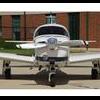Pressurized pistons really don't work which is why you really don't seem them today (the Malibu isn't exactly setting the world on fire and there is no piston twin being made that I can think of).
Time to climb into FL's unless there is a hell of a tailwind the climb time eats all the TAS speed gained unless you are going a very far distance. Most GA flights aren't long distances and burning 24+ in the climb limits range.
I can get 160-170kts TAS between FL190-210. I fly a lot of GA long haul (mostly KDPA<->47N). Rarely does the math ever work to go high and I am looking solid west to east. If it does it is usually 15-30mins of savings to be on O2 (which is additonal cost but a bottle cost is a lot less than maintaining a pressure vessel and its acccessories). You also have all the bootstrapping, mag, no heat, 1hr of 100% power wear, lousy CHT cooling issues to deal with..
Money, time, fuel, reality is it just doesn't work to fly pistons in the FL's consistently thus no reason to be pressurized.
While one can say Mooney could have made a turbine single in the 60's it sort of falls into the same issue as the M22. The engines available at the time just didn't work.
Look on FlightAware at turbo Barons, super charged Tbones, turbo Senneca's, turbo Mooney's, turbo Bonanza's, etc. and they are all 9-11k feet.

